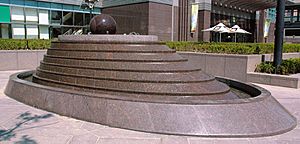Feng shui facts for kids
Feng shui (simplified Chinese: 风水; traditional Chinese: 風水) is an ancient Chinese practice. It's all about arranging your surroundings to create good energy and improve your luck.
The words "Feng shui" mean "wind and water" in Chinese. This system was developed by Taoist thinkers. Many people still use its ideas in their daily lives today.
Feng shui uses five main elements: Fire, Earth, Metal, Water, and Wood. These elements work together in special cycles:
- Fire helps create Earth.
- Earth produces Metal.
- Metal holds Water.
- Water helps Wood grow.
- Wood fuels Fire.
There are also cycles where elements control each other:
- Earth blocks Water.
- Water puts out Fire.
- Fire melts Metal.
- Metal cuts Wood.
- Wood uses up Earth.
Different groups teach Feng shui, like "The Western School of Feng Shui" and "The American Feng Shui Institute."
How Feng Shui is Used Today
Even today, many experts study traditional Feng shui ideas. Here's how:
- Landscape ecologists look at how Feng shui helped save old forests in Asia. These "Feng shui woods" are important for culture and for protecting different plants and animals. Some think these woods show that ancient Feng shui ideas about healthy homes and nature were very smart.
- Environmental scientists and landscape architects research the methods used in traditional Feng shui. They learn how people in the past thought about their environment.
- Architects study Feng shui as a unique and old Asian way of designing buildings. It helps them understand how spaces were planned for good energy.
- Geographers have used Feng shui techniques to find old places in Canada and archaeological sites in the American Southwest. They found that ancient Native Americans also thought about stars and land features when choosing locations.
Images for kids
-
A feng shui spiral at Los Angeles Chinatown's Metro station
-
A traditional turtle-back tomb of southern Fujian, protected from "noxious winds"
-
Sycee-shaped incense used in feng shui
See also
 In Spanish: Feng shui para niños
In Spanish: Feng shui para niños






